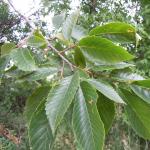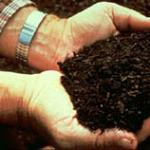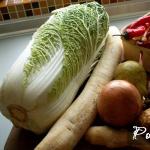
Lemon tree from the bone in the home. How to plant a lemon at home
Lemons ... this tropical wonder can be grown at home, even on a windowsill. To successfully plant a lemon at home from the bone, you need to know the characteristics of planting. The article will inform you what, when and how it is necessary to do so that the lemon tree grows healthy from the stone and has abundant fruit.
On the question of how to plant a lemon with a stone, and even achieve active fruiting, many gardeners shrug. However, it is not. If you adhere to all the rules, landing techniques and care, then after 4-5 years it will be possible to begin harvesting.
The main key to success is the correctly chosen seeds and the process of planting. First, pick a couple of ripe, undeformed, and intact lemons. Wash them, cut them in half and select the largest seeds. It is desirable that the bones when planting must necessarily be wet. Dry seeds will not grow well, or even remain in the ground.
Treat them with a natural stimulant by placing in the solution overnight. It is necessary to use biological stimulants in order for the lemon roots to actively grow and develop in the future. In the morning, you should prepare a solution of one of the bioregulators, for example, "Epin-Extra" or "Zircon". To do this, add a drop of the drug to a glass of water and immerse the seeds for 12 hours. This treatment will help seedlings cope with the lack of lighting and dry air in the room.
In order to plant a lemon from the stone, prepare shallow and small containers. You can buy ready-made in a specialty store or make it out of handy material, such as yogurt cups or you can cut plastic bottles to the desired size. Before planting, make holes for drainage at the bottom of prepared dishes. Lay a drain on the bottom of the pot (you can use vermokulit) in a layer of 1.5 cm. It is recommended to plant several dozen stones at once. This will help in time to choose the best and healthy seedlings. After all, not all will germinate.
Before planting a lemon from the stone, it is necessary to prepare a fertile and loose soil. Perfect land for planting citrus, which is sold in flower shops. And you can cook a fertile mix yourself. Take equal amounts of turf and humus, mix as thoroughly as possible and add peat. The mixture is lightly moistened and placed in a prepared shallow container. Seeds are placed at a depth of approximately 2 cm.
In the room where the lemon will be planted from the stone, there should be an air temperature of +18 degrees and no less, otherwise the seed will not germinate. And how to plant a lemon from a bone, if you have a little cool? To successfully grow out of the stone, you need to create greenhouse conditions (in the photo - one of the ways in which cut plastic bottles are put on the cups). To do this, the pot is carefully covered with foil and placed in the warmest and draft-free corner of the apartment or house. The abundance of light or lack of it does not affect the growth of seedlings.
But with watering need to be careful. It is advised that the pot with the planted seeds should not be watered at all, so that the moisture does not contribute to the death of the appearing roots. It is advisable to carry out spraying 2 times a week. And water when the earth begins to crack.
Growing up
The time of appearance of sprouts depends on the temperature in the apartment. It usually takes from 2 weeks to 1 month. As soon as 4 and more leaves appear on the sprout, you can remove the film if you have made a greenhouse, and place the pot with the sprouts in a well-lit place. It is important that young leaves are not exposed to direct sunlight, otherwise the young sprout will die. Watch for watering. Water the soil as it dries. Water should be pre-settled and be at room temperature. It is recommended to use rainwater for irrigation, but make sure that this water is not cold.
You should not feed the lemon sprout in the first months. In the spring and summer, once in 14 days you can add a little fertilizer. But only a little, proceed from the fact that it is better to feed less than to overfeed. Remember, the lemon tree is very demanding and capricious. The slightest disturbances in care and changes in the environment will be reflected in the tree very adversely. Excessive sun, strong wind and draft can cause your plant to lose foliage. Non-compliance with the temperature regime is also undesirable for a sprout.
With the arrival of autumn, watering is carried out as rarely as possible. Landmark - the state of the upper layer of the earth. Top dressing is necessary only once in 30 days.
It is worth starting to form the crown in time, it must be done already in the first year of the young sapling's life. All weak, growing inward and deformed branches should be removed.
As soon as the seedlings germinate, you should choose the strongest and transplant into a larger pot.
In order to choose the right seedlings for transplanting, you should pay attention to the following criteria:
- crown. We must look at its density. To determine this, pay attention to the distances that are between the buds on the lemon seedling - they should be minimal.
- needles. Their number on the trunk should be minimal.
- leaves. The more, the better. Well, if they are strong and do not fall from the minimum breeze.
All seedlings that are weakened, have thin shoots and not enough leaves, must be rejected immediately.
Care
Transplantation should be carried out together with the earthy ball in which the seedlings grew. Add biohumus to the pot with fertile soil. The diameter of the new “place of residence” should be approximately 7 cm larger than the old one. It is at this moment that the sapling can be formed. To cause the growth of lateral shoots, pinch the top of the lemon seedling. For the uniform development of the crown of the tree should be a quarter turn to turn it 1 time in 10 days. Due to a well-formed stem, high-quality fruits can be obtained in the future.
Further care for an adult tree is carried out according to the rules described above. Proper watering, sufficient lighting (in the winter, do not forget to use fitolampy) and appropriate feeding. Use both mineral and organic fertilizers, alternating between them. Keep the interval between dressings to be no more than 10 days. Use only liquid form fertilizer. The permissible dose of mineral fertilizer will be 2 g. If you add more, you can burn the root system of the plant.
If the tree already in the first year began to bloom, be sure to remove all the buds, although you will be doing this and it is very pitiful. If this is not done, the young sapling, having spent all his strength in the flowering process, will begin to wither. According to the rules, flowering should take place when there are not less than 15 leaves per 1 flower.
Be aware that a young tree should be replanted 1 time in two years. And an adult lemon tree needs transplanting less often - once in 3 years. These time intervals must be adhered to in order that the root system of the tree does not lack the discomfort in the pot and does not become tangled. If this happens, the lemon tree will stop growing. Replanting, be careful not to damage the roots. Each time you change a pot, a new one should be larger in diameter, usually 4-6 cm. The optimal time for a transplant is in summer - June, and in winter - February.

In order for the homemade lemon to bear fruit as early as possible, it is imperative that it be grafted onto citrus fruits (for example, grapefruit). The best time for this agrotechnical event is summer or the end of spring. Inoculation can be done in two ways: by budding or splitting. The most successful and optimal consider exactly graft splitting.
The evergreen lemon tree is not only beautiful, but also useful. Even before the appearance of the fruits, it will benefit you and your home. That's because its leaves are able to release active biological substances - phytoncides. They interfere with reproduction in the air of bacteria and various pathogens. After reading this article, you learned how to plant a lemon from a bone, so that it grows and turns into a beautiful tree. Even if you had failed attempts before, try again. After all, now you already know exactly how to grow a lemon tree from a stone to eat the exotic fruits of your own harvest.
Video "Growing citrus houses"
This video will show how to grow citrus fruits at home.
Our country is not suitable for the cultivation of lemons because of the harsh climatic conditions. However, it is possible to create suitable conditions in the apartment. But first you need to figure out how to plant a lemon from a bone.
Select and prepare bones
Bones for planting need to take fresh, large and not damaged. It is better to take a few, because not all will be viable. Bones need to be treated with sodium humate - put bones in the solution for a day.
Experts say that Epinas ekstra can also be used, which accelerates growth and increases the resistance of the plant to dry air.
Prepare the ground
Lemon tree loves loose and nutritious land. You can use humus mixed with coal or deciduous-sod soil mixed with sand. You can also buy ready-made citrus primer at a flower shop.
Before planting the ground must be moistened.
How to plant a lemon from the stone
There are many options for how to plant a lemon from the bone. But most often the bones are planted in separate small containers (for example, plastic cups) with several drainage holes to a depth of about two centimeters.
Watering is not necessary, as too wet soil contributes to root rot. Containers with stones should be covered with glass jars or placed in plastic bags. Once a day, these mini-clips need to be opened.
The air temperature in the room should not be below 18 ° C. The seedlings will appear no earlier than in three months. When two pairs of leaves appear, the lemon leaves should be transplanted from pots with the same soil as was used for planting the seed, and rearranged to a well-lit place.
How to care
It is not enough to know how to plant a lemon from a stone. You also need to know how to care for this plant. The most important aspect is moderation when watering.
Excess moisture is not less harmful, as its lack. Watering a lemon tree should only be warm water. But the main problem is temperature.
For development, the lemon needs a sufficiently high temperature (not lower than 18 ° C), but at the same time it needs a lower temperature (10-12 ° C) during the wintering season. Therefore, in winter, you need to put the lemon in a cool place. In autumn and in winter, you need to apply top dressing once a month, in spring and summer - once a week.
This mode is due to the fact that lemon grows unevenly. It is necessary to fertilize it only during that period when growth occurs. Lemon likes frequent transplantation. The best time for this is February and June.
When the tree grows up, you can replant it every three, four years. With each transplanting pot should be five centimeters more than the previous one. During transplantation you need to ensure that the roots are not damaged.
How to instill
How to plant a lemon from a stone is more or less clear. But you want him to bear fruit. To do this, it is necessary to inoculate it with the help of a stock - a grapefruit seedling. Plant a grapefruit seed.
How to plant a lemon.
After it rises, it is necessary to “seed wedge” in cotyledon leaves and plant a lemon stalk into the seedbed. The vaccine should be wrapped with polyethylene for two or three weeks - until the vaccination is in place.
Read more:
Ways to grow lemon
Wildlife is rich in citrus plants. Trees, shrubs are small, but they still do not suit the house. Homemade lemon tree has a height of about two meters.
The most suitable varieties: Mayer, Pavlovsky, Novogruzinsky, Nizhny Novgorod. If you want a shorter plant, then take Eureka, Genoa.
Kursk, Maikop, Ural - the most fruitful species. There are several ways to grow lemon at home: sow seeds, plant sprouts, inoculate. From the method will vary the characteristics: both the appearance and the fruits.
Seeds are planted immediately, removing them from the fruit. Three weeks later, the first shoots will appear. But this method will give a harvest rather soon - after 5-6 years. The most optimal way of citrus cultivation is by cutting.
Selection and care of seedlings
You can purchase any in nurseries, botanical gardens, or from experienced gardeners. A stalk with a length of 15 centimeters and a thickness of about 5 mm should have 3-4 young leaves. You can treat it with a special stimulant to grow roots faster.
Before planting, deepen the sprout in the water at half the height. After 2-3 days, place it in a soil fertilized with humus with 1: 1 sand. Ready soil is sold by specialized shops. All you have to do is add some sand there.
And you can take the already fertilized land from the garden plot. Take a plastic large bottle with a holed bottom. Cut it in half. Fill both halves with ready ground.
Plant an escape there, pour a small amount of slightly warm water. Connect both halves, cover with a glass jar on top. Place a container with a handle near the window. Make sure that there is no draft, direct sunlight, cold.
The optimum temperature is 20 degrees Celsius. After three to four weeks, the plant will take root. Can be transplanted.
Dishes
Homemade lemon tree does not like frequent transplants. Therefore, immediately take a spacious container. This may be a ceramic pot, with holes at the bottom.
Each time it must be larger than the previous one.
Lemon tree care
Home conditions require proper lemon care. Initially, choose a place for it to no longer move. Desirable south or southeast side.
Lighting
The plant is photophilous, especially young. At least 2 hours a day, let it get direct sunlight. Just choose not the hottest time! Next come the usual diffused bright lighting.
In winter, you need to use additional lighting. To form a beautiful crown, the tree can be rotated every day quite a bit. It should have time to turn the leaves behind the light.
Temperature
Homemade lemon tree loves moderate warmth. The optimum temperature is 18-25 degrees Celsius. In winter, you need to provide cooler conditions - + 12-15 degrees. It stimulates, accelerates fruiting.
The main thing - good lighting, no drafts, a sharp temperature drop. Otherwise, the plant can get sick, stop fruiting.
Humidity and watering
Citrus requires an average humidity of 60-70% at a temperature of about +20 degrees. Spray once or twice a day, especially in summer. In winter, you also need to moisturize.
Dry air leads to the appearance of pests. In the spring-summer period, the plant needs to be watered daily. If the heat - even twice. When frost watering is reduced to two times a week.
Eliminate stagnant water in the roots - a lemon can die. Overdrying of soil leads to diseases, the appearance of pests.
Soil features, fertilizer
The soil is taken fertilized with organic, chemical nutrients. You can use the finished store mix.
Ground recipe for young plants:
- turf, 2 parts;
How to plant a lemon at home?
The question of how to plant a lemon is often asked. After all, each person wants not only to grow a green tree, but also to receive its wonderful fruits at home.
Ways to grow lemon
To grow a lemon at home in three ways: 1. By planting a sapling. The important point is the choice of a healthy specimen with a well-developed root system.
First, you need to pay attention to the humidity of the roots: if they are dry, then the seedling can not settle down. Small roots, drying, die off.
During the purchase, make sure that the roots of the seedling were in wet sawdust, were quite branchy, and the seedling itself had several old dense leaves. Sprouting lemon seeds. To do this, you need the largest bone, extracted from fresh lemon.
When a seedling grows from a seed, it must be planted; otherwise, the lemon will not bear fruit. Planting a cutting taken from a fruiting lemon tree. This is the most rational way of growing lemon.
A tree grown from a cutting will begin to bear fruit 2 years earlier than that grown from a stone. In addition, it does not need to be vaccinated, and the fruits will be exactly the same as that of the parent lemon. If your acquaintances or friends have a fruiting lemon tree, then you have a great opportunity to quickly grow a lemon tree.
Growing Lemon from Stalk
Cuttings can be planted all year round, but it is best to do it in spring. Fourth or fifth order cuttings take root well. Shoots of the current year rooted poorly.
Branch for cutting should have a few leaves. The top sheet is left intact, the next ones are cut in half, and the bottom one is removed completely. The cuttings are planted in a pot with nutrient soil and covered with glass or film.
Rooted cuttings in a well-lit place at a temperature of + 20-23 degrees. Watering is carried out regularly, ensuring that the soil was moderately wet. Excessive waterlogging may cause the lower part of the cutting to rot.
Better yet, spray cuttings twice a day with tepid soft water. When the first leaf appears, remove the film or glass from the pot. They do this not immediately, but gradually: the first day is 2 hours, and in the following days the time is gradually increased.
Usually rooting takes a month, after which the stalk with roots is transplanted into a pot with a diameter of 10 cm. For planting a soil mixture is prepared from sod and leaf earth, humus and river coarse sand in a ratio of 2: 2: 2: 1. At the bottom of the pot, the river pebbles are poured, the soil mix is lightly poured, and then the lemon is transshipped so as not to destroy the earthen clod. The destruction of the old earth coma can cause damage to the root system, which will cause a significant slowdown in growth. The next transplant will be needed in a year, and the first fruits can be expected no earlier than in 3 years.
How to grow a lemon from the stone
Fresh, not having time to dry, lemon bones are planted to a depth of 2 cm. The pots are covered with film or glass. Watering is better to replace the daily abundant spraying of the soil, since excessive moisture can lead to decay of young roots.
Temperature range is kept within + 18-21 degrees. With the advent of the first leaves, the film is gradually removed, accustoming young sprouts to natural indoor conditions. When the root system becomes crowded in a small pot, a lemon is transplanted into a 10 cm pot. In the future, all transplantation procedures are performed similarly to those described in the section on growing a lemon from a cutting.
Lemon has its own requirements for care, which relate to placement, watering, temperature and feeding: - lemon - a plant alone. He does not like the close proximity of other plants.
But on this "whims" of lemon do not stop: he does not like any rearrangements and changes in the lighting, does not like when he is once again turned by different sides to sunlight; - from sudden temperature drops, a lemon can throw off the foliage, so it can not stand on terrace or balcony, even in the case when there is a warm summer weather outside. The optimum temperature for keeping lemon at home is + 18-23 degrees.
In winter, temperatures are allowed to drop to +12 degrees; - lemon needs moderate watering throughout the year, as the topsoil dries. Water for irrigation should be soft and slightly warm, necessarily settled, at least for a day.
Tap water with the presence of chlorine causes chlorosis of the leaves, which can cause the death of the plant - Lemon loves spraying and fertilizing, which can be combined with a liquid mineral fertilizer that is specially designed for citrus fruits and contains all the necessary nutrients for the lemon and trace elements. Fertilizer "Flower happiness" for citrus accelerates plant growth, flowering and promotes the formation of fruits. As you can see, there is nothing supercomplex in planting and growing a lemon tree. We wish you success in the form of beautiful juicy lemon fruits!
There are two ways to plant a lemon in order to get a healthy, beautiful and fruitful tree afterwards. You can sow seeds (bones, and you can plant cuttings. What is easier and what results you can get - the answers in the article.
Preparatory work
How to grow lemon at home?
If you are concerned about the question of how to plant a lemon at home and at the same time achieve fruiting, then pay due attention to the preliminary preparation. Soil preparation.
To plant a lemon, it is necessary to take river sand and calcine it in the oven to destroy the bacteria. Then mix it in equal proportions with the citrus substrate. Moisten the mixture.
If river sand was not available, any loose soil can be used, for example, a mixture of humus and leaf turf. The choice of capacity. For planting lemon suitable pots of any material, but preferably still ceramic.
Air exchange is better in them, so the risk of stagnation is less. Pot for planting need to choose a spacious. Before laying the ground it is necessary to pour boiling water over it or soak it in water for several hours.
Drainage. Lemon drainage is necessary to prevent the soil from souring from excessive moisture. Therefore, at the bottom of the pot is to lay a layer of pebbles or stones, they will not let the water stagnate.
But remember that large and sharp stones can cause irreparable harm to the thin roots of citrus. The diameter of the drainage stones should not exceed three centimeters.
How to plant a lemon bone?
Why does not fruit lemon?
It is better to give preference to the bones from the largest and juicy fruits. Lemons grown and ripened in artificial conditions may not rise. Or, over time, do not give fruit.
They can not be stored, because they quickly lose their germination.
- We sow in a pot with a damp ground fresh grains of lemon. Periodically we moisten the soil, while avoiding the accumulation of water, otherwise the bone will rot. Soon the seeds will slip, and small plants will appear. It would be more reasonable to plant several seeds in order to select the strongest of the obtained sprouts after 2-3 months, or plant them in different containers and get a lemon garden at home. When transplanting, try not to touch the earthy clod on the roots. To provide seedlings with normal conditions, place the pots closer to the south or west side, but make sure that sunlight is diffused, direct rays can destroy the plant.
There is an opinion, and its validity has been proved by many experienced growers that a lemon from a stone does not bear fruit. To do this, the resulting tree, when it grows up, and its trunk reaches a thickness of 1 cm, must be planted from the plant, which has already produced fruit. Homes are successfully vaccinated by budding, that is, by a bud with a small piece of bark, in order to increase the chance of double budding.
Planting lemon cuttings
Planting cuttings - one of the most common and effective ways. Selecting cuttings from obviously healthy and fruit-bearing trees, you will know for sure what you will get in the end. Used last year's shoots no longer than 8-10 cm with well-developed leaves.
Plant the stalk in the pot, cover it with a glass jar. Put on the windowsill and periodically spray with warm water, moistening the ground. Everything!
It remains only to wait a bit, and your stalk will gain roots. When the upper buds begin, gradually begin to teach the seedling to the microclimate of the room, removing the jar for a short time.
During the week, increase the seedling's stay on the air without a can in order to remove it completely by the end of the week. If heating devices or central heating are located close to the tree, you can isolate it from them with a piece of plywood or cardboard.
A very naughty lemon plant, planting and caring for it requires not only knowledge and experience, but also selfless labor. It needs special conditions, temperature drops, drafts and overheating are contraindicated. But all the efforts of a diligent gardener will be rewarded when the salted lemon gives up its first fruit.
Lemon Corn
Among gardeners there is an opinion that the cultivation of indoor lemon, bearing fruit, the task is quite difficult. However, as practice shows, with proper planting and regular care, it is possible to grow a fruit tree at home for 4-5 years.
It is known that the fruiting of citrus, grown from the stone, occurs in 6-8 years. Plants obtained by grafting or grafting begin to yield much earlier. A lemon bush grown at home reaches a height of about 2 m, has smooth, dark green leaves with a characteristic citrus smell, a thin stem with a dense reddish bark and many branches.
Less common are individuals reaching up to 4 m in height, but it is rather difficult to care for them in indoor conditions. The lemon tree looks very attractive, therefore it serves not only to produce fruits, but also decorates the room. In good conditions, the plant blooms and bears fruit year-round.
How to plant a lemon from the stone: photos and description
One of the most common ways of reproduction of this culture is the cultivation of stone. How to plant a lemon from the seed? For this, large seeds are extracted from fresh, ripe lemons.
Then they are immediately planted in a small container to a depth of 1.5-2 cm. Pots should have drainage holes, as citrus does not tolerate stagnant moisture. At the bottom of the pot lay a layer of drainage, poured on top of fertile, fresh soil.
It is possible to plant several stones in one container, this will give an opportunity to choose the largest and healthiest from the emerged shoots. Before planting, moisten the soil. After the seeds are sunk, the pot is covered with a film.
Watering the planted seeds is not recommended, because it can lead to their decay. It is better to plant a lemon from a stone in a clay pot, since clay regulates soil moisture. With an excess of moisture, it absorbs it, with a lack of - gives the plant.
How to grow a lemon from the stone at home
How to grow a lemon from the stone? Germinate seeds at a temperature of 18-20 ° C. The first shoots will appear in 2-3 weeks. The film is removed after the second pair of leaves is formed.
Shoots watered very carefully, because an excess of moisture will lead to their death. Young individuals watered with warm, settled water. The first 2 months feeding is not required.
The grown-up plants weekly feed up with solution of mineral and organic fertilizers. From grown-up sennets leave only those that have signs of a productive lemon. These features include a developed root system of the plant (evidenced by the slight distances between the buds on the stems), strong leaves, the presence of thin shoots. Having chosen the most promising plants, they continue to work on their development. How the lemons grown from the stone look can be seen in the photo below:
How to transplant homemade lemon
How to transplant homemade lemon? Young lemons need a regular transplant. Transplantation is performed as the root system develops. Replant the tree in a more spacious container.
This work is done very carefully so as not to damage the root system. As it grows, the tree begins to bush. In order to form a compact, regular crown, pinching of young shoots that have grown on top are carried out. In addition, pinch the leaves growing on the side shoots.
Planting and growing indoor lemon cuttings
How to grow a homemade lemon from the stalk? It is believed that this method of breeding plants is more simple than growing out of a stone. In this case, the probability of a good yield of the tree increases. Planting lemon cutting can be done in the ground or in the pot.
In late winter - early spring, cuttings of adult plants that have reached 10–15 years are selected. At the same time, 4th and 5th order branches are used. The escape itself should be slightly lignified.
After planting, they produce watering with separated water at room temperature, the top is covered with a glass jar to create a “greenhouse”. "Greenhouse" cleaned after full rooting of the plant. Planted stalk put on the lit place.
Water as the soil dries. Transplantation of a lemon grown in this way is carried out in the same way as transplantation during seed reproduction. The tree begins to bloom and bear fruit after 2 years.
In some cases, lemon bloom begins before this period. In order for the tree not to consume the nutrient supply for premature flowering, it is recommended to pluck out the flowers that have appeared.
The fruits of them are not formed, and the nutrients to maintain flowering will take quite a lot. A year after planting, the cutting at the bottom and at the top of the trunk removes excess shoots. Growing a lemon at home is not easy, because it is quite whimsical, demanding of light, moisture and air temperature.
In addition, the tree does not tolerate change of place and temperature drops. In both cases, the tree sheds foliage, which negatively affects its fruiting. Therefore, when growing citrus, it is important to take into account all its features and provide optimal conditions for growth and development.
How to plant a lemon at home
In what soil to plant a lemon at home? You can purchase a soil mixture for indoor plants in the store or make it yourself. There are 2 options for such mixtures.
In the first case, you will need turf ground (2 hours), leaf earth (1 hour), humus (0.5 hours), river sand (0.5 hours), crushed charcoal. You can make a mixture of garden soil (2 cups), river sand (1 cup), humus (3 tbsp. spoons), ash (1 tbsp. spoon). All components are mixed.
Water is added to obtain a thick mass. In order for the tree to produce a rich harvest, periodic fertilizing is required. The amount of fertilizer is increased in the spring. In winter, the number of dressings is minimized. Any capacity is suitable for planting young plants.
Trees that have reached the age of 3 are transplanted into wooden tubs made from softwood trees. Planting lemon at home can be carried out at any time of the year, but the best time for this is considered February-March.
Recently, more and more exotic fruits appear on store shelves: lemons, pineapples, kiwi, avocados and others. But is it possible to plant a lemon or other exotic fruit at home, if so, how can it be properly planted so that it can bear fruit and please others?
How to plant a lemon at home from the bone
In order for a lemon to grow at home and please with its fruits, you need to properly prepare the soil.
First you need to calcine the river sand in the oven to kill all the bacteria in it. After mixing it 1: 1 with citrus substrate. Moisturize the mixture. If river sand could not be found, then it can be perfectly replaced: a mixture of humus and leaf turf.
You also need to choose the capacity for planting a lemon, for this purpose any flower pot is suitable, but it is better if it is made of ceramics. It is in such a container that air exchange is better, and this means that there will be less stagnation. The pot should be spacious, before planting a lemon, you need to soak it in water for a few hours and pour boiling water over it.
Drainage in a pot must be provided to prevent the earth from acidifying from excess moisture. At the bottom of the container can be put pebbles or small pebbles. Do not use stones with sharp corners and too large, they can cause irreparable damage to the root system and the lemon will die quickly.
Lemon planting at home
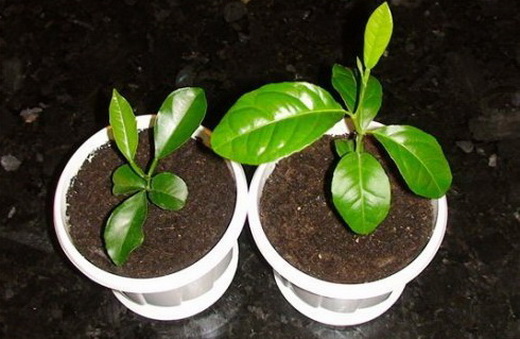
Choosing seeds for planting lemon, give preference to those that were found in a large and juicy fruit. Those lemons, which were grown in artificial conditions or ripened not on a tree, can not please shoots. They can not be stored, as they very quickly lose their germination.
- Fresh grains, selected from lemon, are sown in a pot with prepared soil.
- Periodic need to moisten the earth, but make sure that the water does not accumulate, otherwise the grains of lemon will rot.
- Very soon, the grains of lemon will hatch and small sprouts will appear.
- It would be good to plant several grains of lemon at once, so that after they grow up, one can select the strongest ones or simply plant them in different containers and get several plants at once.
- During the transplantation of a lemon, you should try not to touch the soil on the root system.
- Set the pots with lemon seedlings so that they are always illuminated by sunlight, but are not under the scorching rays that can destroy them.
But it is believed that lemon, grown from the stone, does not give fruit. It is for this reason that many gardeners prefer to grow lemon cuttings.
Planting lemons cuttings
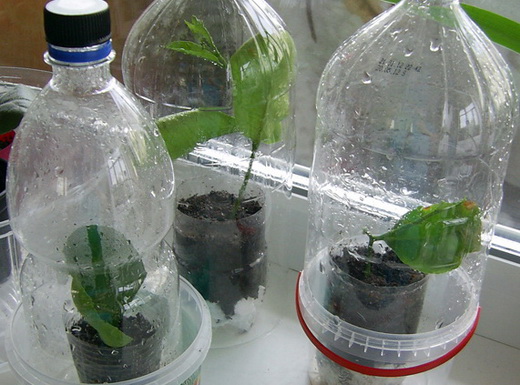
Cutting is considered the easiest and easiest way to grow plants, this also applies to citrus. Lemon, planted from the cutting, begins to give fruit within 5 years after planting. So, how to plant a lemon cutting at home?
- First you need to find a good strong cutting, perhaps you have friends who already have a big tree - a lemon. Or maybe you managed to buy a good lemon shoot.
- Next you need to prepare the soil mixture, for this you need river sand and soil for citrus. Prepare the mixture should be the same as for planting lemon seeds.
- The rooting of a lemon for rooting should be about 12 cm long and should contain about 4 already developed buds. The lower cut needs to be done so that it is as close as possible to the kidney. The bottom sheet must be removed completely, and the rest cut off by half.
- Before planting, the lemon stalk is soaked in a clock root stimulator solution at 12. Before planting, the lemon stalk should be dipped in wet sand and sprinkled with charcoal. Thus, it is possible to protect the cutting from rotting.
- Prepared lemon stalk should be placed in wet sand to a depth of no more than 2 cm, spray with warm water and cover with a can, creating the effect of a greenhouse. The pot is placed in a well-lit place, but without direct sunlight. Care must be taken to ensure that the sand remains constantly wet and, if possible, spray the lemon stalk once a day. After 2-3 weeks, the first roots should appear. It is possible to determine whether a stalk of lemon has taken root by the new young leaves that have appeared.
- Now it is necessary to temper the plant. Every day you need to briefly remove the jar from the plant, while adding the amount of time. After 14 days after such procedures, the bank can be removed completely.
- Now it will be possible to transplant the rooted lemon in the pot. To do this, on its bottom you need to pour clay or broken brick to create a drainage. Its thickness should not be more than 1/5 of the height of the pot. After you need to fill the ground and sprinkle it with charcoal, and then again the ground. After making a small indentation, transplant a neatly rooted lemon stalk. The depth of planting a lemon should not be greater than when rooting. Put the pot in a bright place, be sure to ensure that the earth does not dry out. Lemon develops well with moderate watering.
If you follow all the rules of planting a lemon, then after 5 years the lemon will delight with its fruits, the aroma from it will diverge throughout the house.









